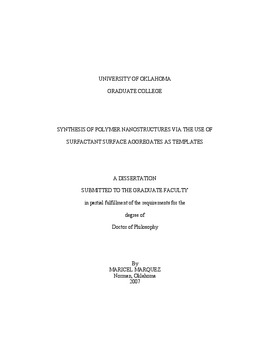| dc.contributor.advisor | Grady, Brian P., | en_US |
| dc.contributor.author | Marquez, Maricel. | en_US |
| dc.date.accessioned | 2013-08-16T12:21:03Z | |
| dc.date.available | 2013-08-16T12:21:03Z | |
| dc.date.issued | 2007 | en_US |
| dc.identifier.uri | https://hdl.handle.net/11244/1321 | |
| dc.description.abstract | The subject of this work is the synthesis of polymer nanostructures via the use of surfactant surface aggregates as templates, also termed Template Assisted Admicellar Polymerization (TAAP). The first chapter reviews some of the most current nanopatterning techniques (including both top-down and bottom-up approaches), with particular emphasis on the fabrication of organic and inorganic patterned nanostructures via particle lithography. In chapter 2, highly ordered hexagonal arrays of latex spheres were prepared on highly ordered pyrolytic graphite (HOPG) from a variation of the Langmuir Blodgett technique, using an anionic surfactant (SDS), and a low molecular weight (ca. 10000) polyacrylamide as spreading agents. When a nonionic polyethoxylated (EO = 9) surfactant was used as the spreading agent, no ordered arrays were observed. Based on the correlation found between the surface tension in the presence of the latex particles and the critical concentration at which hexagonal arrangements of latex spheres occurs; a model was proposed to explain the role of the spreading agent in forming stable monolayers at the air/liquid interface, which in turn are necessary for the formation of well-ordered monolayers on a solid substrate from the LB technique. According to this model, solid-like regions of small numbers of latex spheres form at the liquid-air interface, which are then transferred to the substrate. These ordered regions then act as nuclei for the formation of 2D arrays of latex spheres on the surface upon water evaporation. The role of other factors such as relative humidity, substrate and solvent choice, and pulling vs. compression speed were also found to affect the quality of the monolayers formed. Finally, a simple, easy to automate, yet effective surface tension method was proposed to predict the optimal conditions for the formation of ordered monolayers using a variation of the LB deposition method from any monodisperse set of spheres. | en_US |
| dc.description.abstract | In chapter 3, a novel method for the formation of nanometer-scale polymer structures on solid surfaces via template assisted admicellar polymerization (TAAP) is described. Admicellar polymerization uses a surfactant layer adsorbed on a surface to localize monomer to the surface prior to polymerization of the monomer. TAAP refers to nanostructures that form by restricting adsorption to the uncovered sites of an already-templated surface. In this case, the interstitial sites between adsorbed latex spheres were used as the template. Unlike most other process that form polymer nanostructures, polymer dimensions can be significantly smaller than the interstitial size because of sphere-surfactant-monomer interactions. As a proof of concept, nanostructures formed via TAAP were compared to structures prepared by others via adsorption of three different proteins (Bovine serum albumin, fibrinogen, and anti-mouse IgG) in the interstitial sites of colloidal monolayers. The size and shape of the nanostructures formed (honeycomb vs. pillars) was dependent upon the size of the spheres utilized and the method of polymer deposition (i.e. admicellar polymerization vs. polymer adsorption). Thinner honeycomb walls, and larger separation distances between the template and the nanostructures were consistently found for TAAP. | en_US |
| dc.description.abstract | In chapter 4, an in-depth study of the factors affecting TAAP is presented for three different monomers: aniline, pyrrole and methyl methacrylate; and three different surfaces: highly ordered pyrolytic graphite (HOPG), gold, and SiO2. Among the parameters discussed are the effect of monomer and surfactant concentration, surfactant chain length, polymerization time and temperature, solution ionic strength, substrate choice and surface treatment. Control over these parameters allowed the synthesis of polymer nanopillars, nanorings, honeycombs, and "honeytubes." Experimental results showed that the nanostructures' morphology can be effectively modified by changing the length of the hydrophobic chain of the surfactant. Nanostructures with fewer defects were found for surfactants with the longest hydrophobic tails (i.e. 12 carbon atoms). The hydrophobic nature of the monomer also seemed to affect the morphology of the nanostructure; poly(methyl methacrylate) (PMMA) honeycombs showed thicker walls compared to polyaniline (PANI) and polypyrrole (Ppy). In general, HOPG seems to be a better choice of substrate for TAAP compared to gold-coated glass and SiO2 wafers. Preliminary results on the formation of layered polymer nanostructures via multiple TAAP sequences were also presented. | en_US |
| dc.format.extent | xxi, 226 leaves : | en_US |
| dc.subject | Nanostructures. | en_US |
| dc.subject | Surface active agents. | en_US |
| dc.subject | Engineering, Chemical. | en_US |
| dc.subject | Engineering, Materials Science. | en_US |
| dc.title | Synthesis of polymer nanostructures via the use of surfactant surface aggregates as templates. | en_US |
| dc.type | Thesis | en_US |
| dc.thesis.degree | Ph.D. | en_US |
| dc.thesis.degreeDiscipline | School of Chemical, Biological and Materials Engineering | en_US |
| dc.note | Source: Dissertation Abstracts International, Volume: 69-03, Section: B, page: 1784. | en_US |
| dc.note | Adviser: Brian P. Grady. | en_US |
| ou.identifier | (UMI)AAI3308317 | en_US |
| ou.group | College of Engineering::School of Chemical, Biological and Materials Engineering | |
